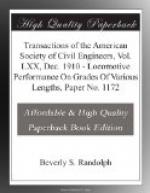[Illustration: Fig. 3.—DEFLECTON curves beam III]
[Illustration: Fig. 4.—DEFLECTON curves beam IV]
In computing the various quantities shown in Table 1, the summary of results, the load has been assumed as concentrated at the center of the beam. While it is true that the load was spread over a length of about 12 in., due to the width of the head of the machine and the plate between it and the beam tested, it is also true that there were irregularities, such as bolt-holes and, in some cases, abrasions due to wear, that could not well be taken into account. Hence, it was deemed sufficiently accurate to consider the load as concentrated. Besides the horizontal bolt-holes, shown in the photographs, there were vertical bolt-holes, at intervals in all the beams. The latter were 7/8 in. in diameter, and in every case they were sufficiently removed from the center of the length of the beam to allow the maximum moment at the reduced section to be relatively less than that at the center of the beam. For this reason, no correction was made for these holes. The broken beams often showed that rupture started at, or was influenced by, some of the holes, especially the horizontal ones.
While some of the heavy oils of a tarry consistency remained, they were only to be found in the sappy portions of the long-leaf pine and in the loblolly (Specimens II and IV). Exposure in a semi-tropical climate for 26 years had resulted in the removal of the more volatile portions of the creosote oil. The penetration of the oil into the sap wood seemed to be perfect, while in the loblolly it varied from a fraction of an inch to 1-1/2 in. In the heart wood there was very little penetration across the grain. The timber had been framed and the holes bored before treatment. The penetration of the creosote along the grain from the holes was often from 4 to 6 in.
Circular 39 of the Forest Service, U. S. Department of Agriculture, entitled “Experiments on the Strength of Treated Timber,” gives the results of a great many tests of creosoted ties, principally loblolly pine, from which the following conclusions are quoted:
“(1) A high degree of steaming is injurious to wood. The degree of steaming at which pronounced harm results will depend upon the quality of the wood and its degree of seasoning, and upon the pressure (temperature) of steam and the duration of its application. For loblolly pine the limit of safety is certainly 30 pounds for 4 hours, or 20 pounds for 6 hours.” [Tables 3, 6, and 7.]
“(2) The presence
of zinc chlorid will not weaken wood under static
loading, although the
indications are that the wood becomes brittle
under impact.”
[Tables 3 and 4.]
[Illustration: Fig. 5.—DEFLECTON curves beam V]
[Illustration: Fig. 6.—DEFLECTON curves beam VI]




